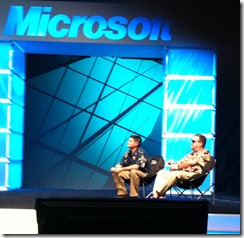My first day on MMS started with the keynote presented by Bob Muglia. The session was streamed and can viewed online here
State of the union
The number one session every year is the State of the Union. This session takes us thru the last 12 months of ConfigMgr and also look 12-18 months into the future of the product. Every year the session starts with a top 10 list. This year the list was about the code names for vNext.
Top 10 – codenames for vNext
1. Code Name vNext won the competition because none of us are really that strong when it comes to code names 🙂
2. Strocomululus Opacus meaning A cloud that covers everything
3. ConfigClan
4. Panamax
5. ConVirt
6. ISCCM – it works for Apple
7. UCCM (didn’t really work. Just think about the acronym for Forefront if that is going to be used with UCCM!)
8. Social networking names like #Wally
9. Borg
10. Classically names like Hermes and a bunch of other old ancient gods.
What has happened the last 12 months?
During the last 12 months the ConfigMgr. team has shipped SP2, a new Dashboard, 64 bit compliant Management Pack, extensions for SCAP and lots of other stuff.
What will happen in the next 12-18 months?
The document team will continue their great work of developing new superflows. We will see the release of ConfigMgr R3 (more to come on that tomorrow), tight integration with Citrix XenApp, tight integration with Adobe and SCUP. Adobe has been working on creating a much richer SCUP catalog that will be easy intergrate.
vNext dates:
· Beta 1 public download May 2010
· Beta 2 – public beta Q1 2011
· RTM H2 2011
In this session we also saw quite a few awesome demos, performed by the Demo Monkey while Bill and Josh took at short break on stage.
Designing the vNext hierarcy
One of the hot topics this year is next version of ConfigMgr. aka vNext. vNext won’t be released until H2 2011. This might lead to thinking that you don’t need to concentrate on the product today – but there you are wrong. With vNext we are going to see huge changes in features and also in the infrastructure design.
In this post I will highlight a few areas.
Site Server characteristics
In vNext you will see some dramatic changes in how we design the ConfigMgr. infrastructure. A new Site is being introduced – the Central Administration Site. Below is a few characteristic on when to use that role and the well-known primary and secondary site.
- Central Administration site
- You will need a CAS if you have more than one primary site and want them linked together in a hierarchy. IN the future all administration will be done from the CAS.
- Primary site
- The PSS will continue to service clients in well-connected network.
- When too add a PSS
- Add primary sites to scale out.
- When not to add a PSS
- You don’t need a new primary site for decentralizing administration, logical data segmentation, client agent settings, language, content routing for deep hierarchies.
- Secondary sites
- Secondary sites will now require a SQL. If SQL is not installed a SQL Express will be installed automatically during the site installation. Sender capabilities will now be added to the DP role. This means that a lot of our secondary sites can be replaced with a DP.
Replication
A new replication model will also be introduced. First you’ll need to be introduced to the data being replicated.
- Global data – Administrator created data like collections, rules etc
- Site data – Client created data like inventory, status messages
- Content data, Software packages
vNext will use SQL replication to replicate Global data between the CAS and all Primary sites. Secondary sites will also receive a subset of the global data (which is why a SQL server is required).
Site data is client created data like inventory data, those data will float up like we know it today.
Content data will go where you tell it to go. Meaning that you control where to send the packages – just like today.
Client agent settings
The way to control Client agent settings is also new. By default you will have basic default client agent settings that cover the entire site. But now you will also be able to create custom client agent settings and apply those to collections.
Role based administration
One of the many really cool features is role based administration. Role based administration is a combination of Security roles and Security scopes. The roles and scope basically defines what you can do and where.
What can you do know?
- Start flatten your hierarchy
- Move to 64 bit
- Start implementing Branchcaching
- Move to SQL Reporting Services
- Start using SCUP and DCM as those rules are very similar to what you will see in the new application distribution feature
Typos caused by jetlag 🙂
